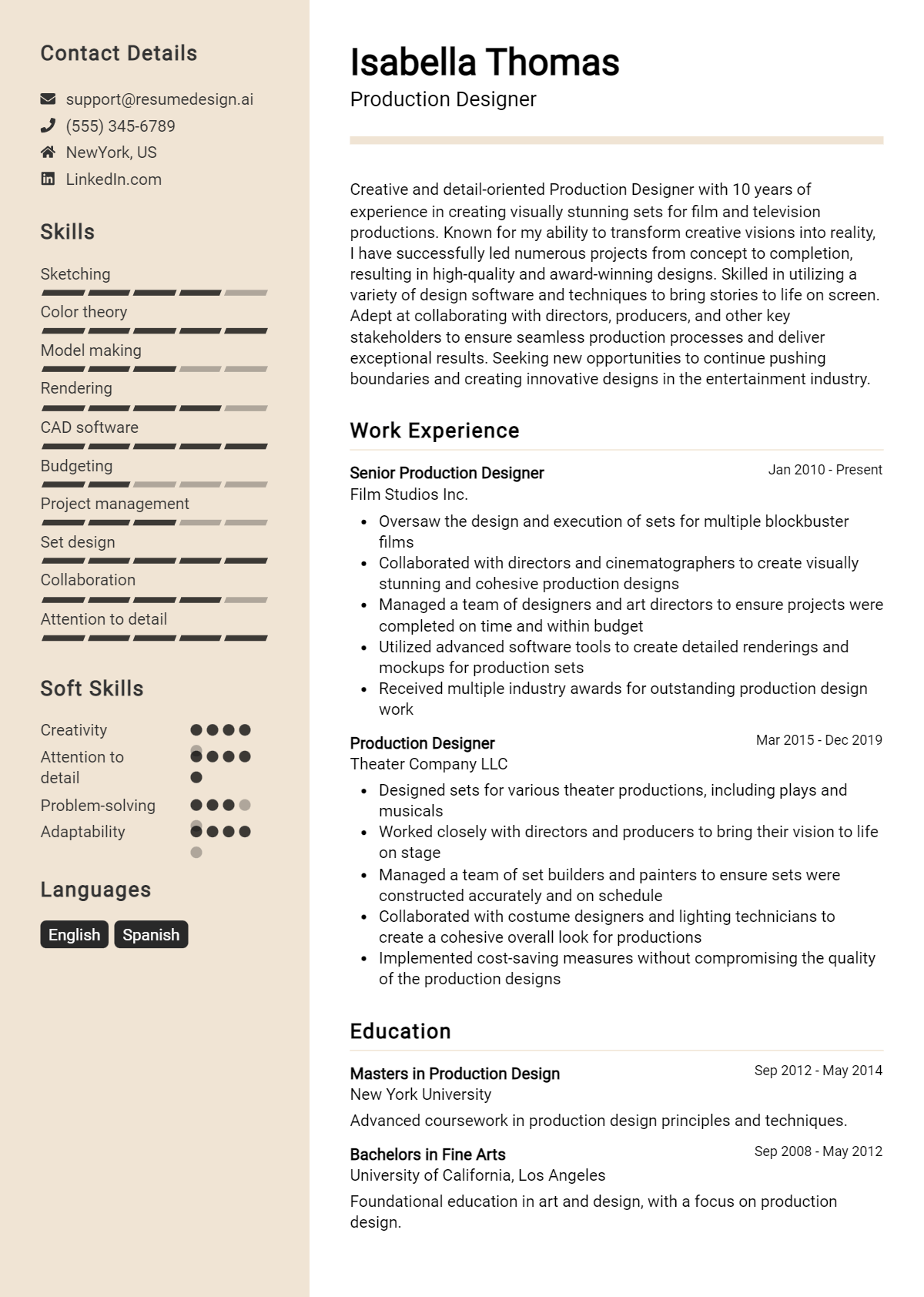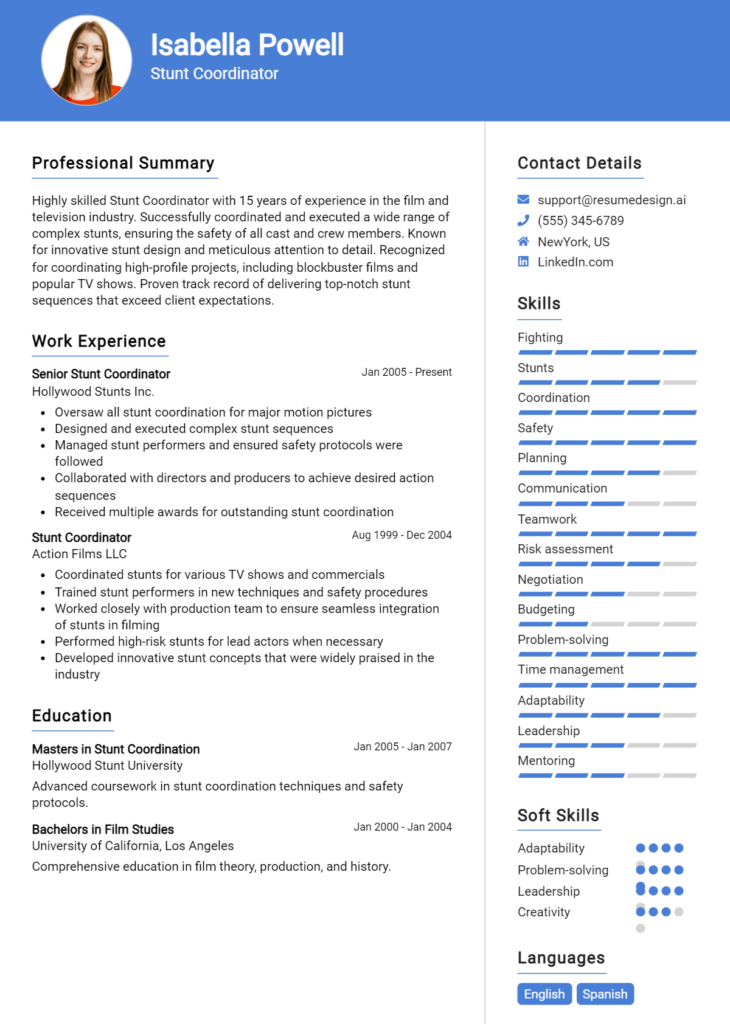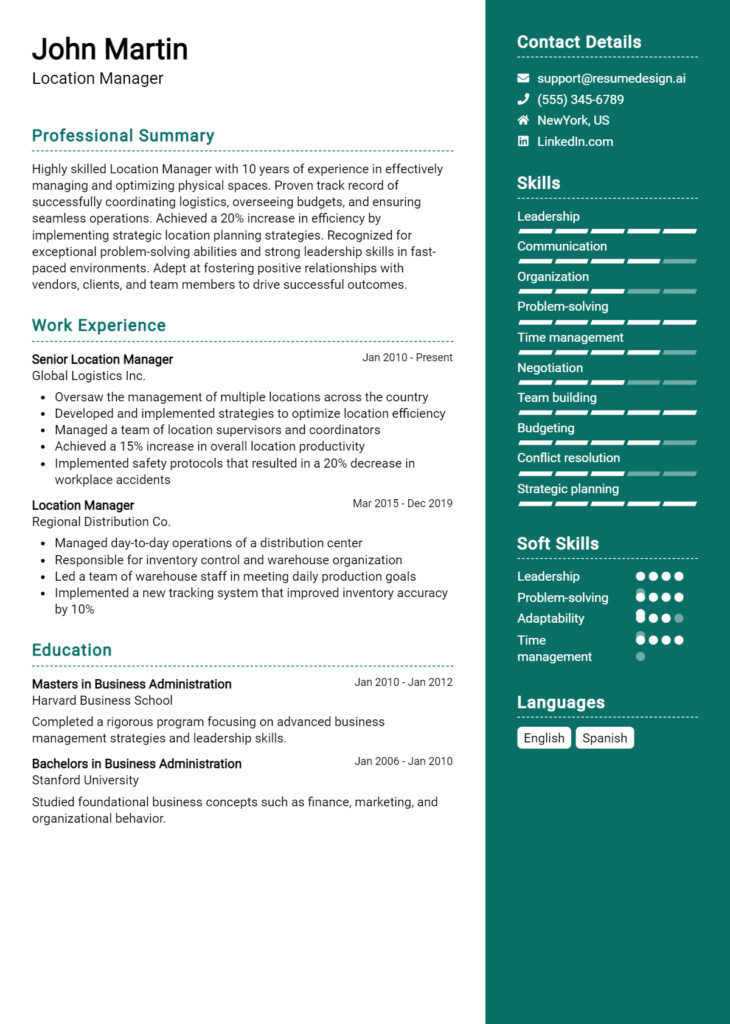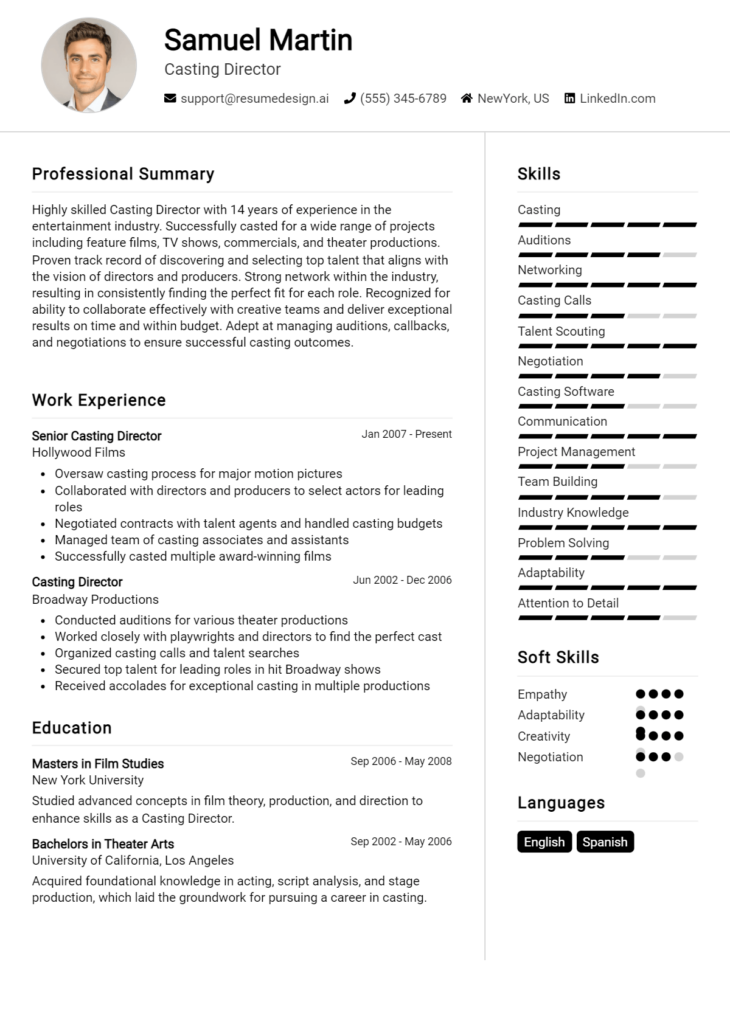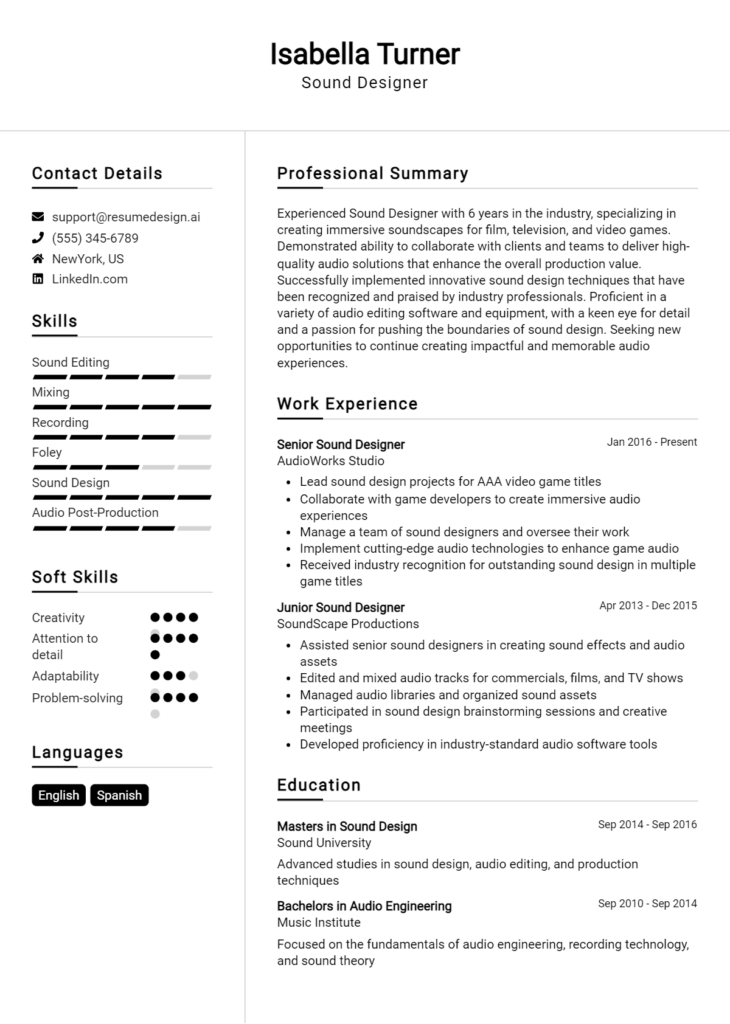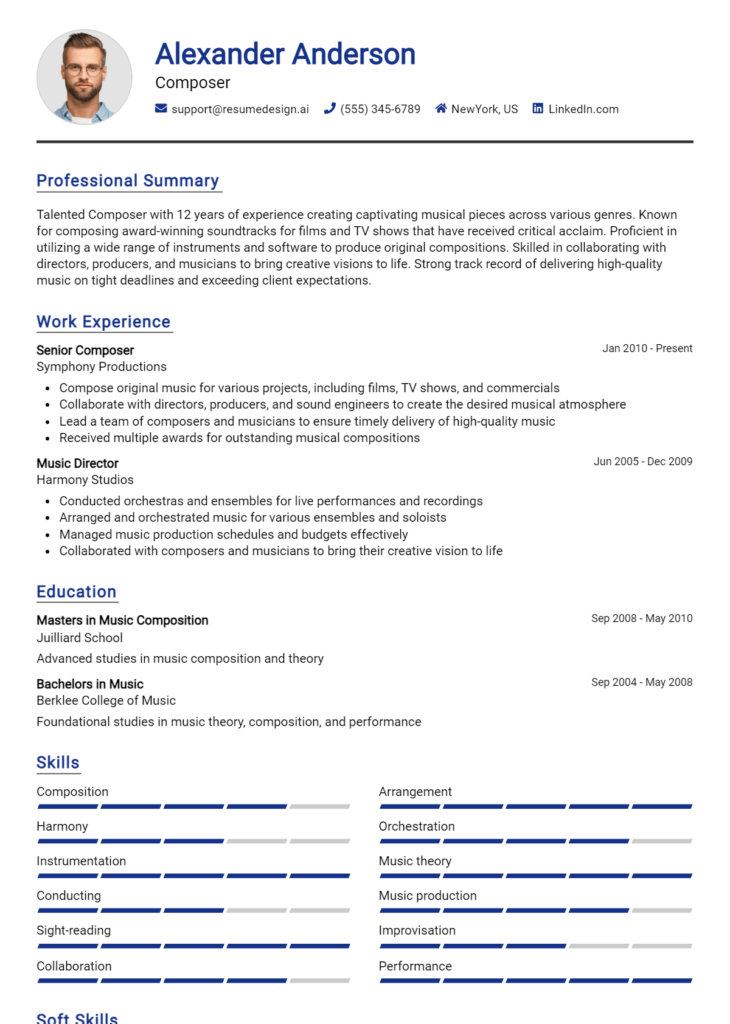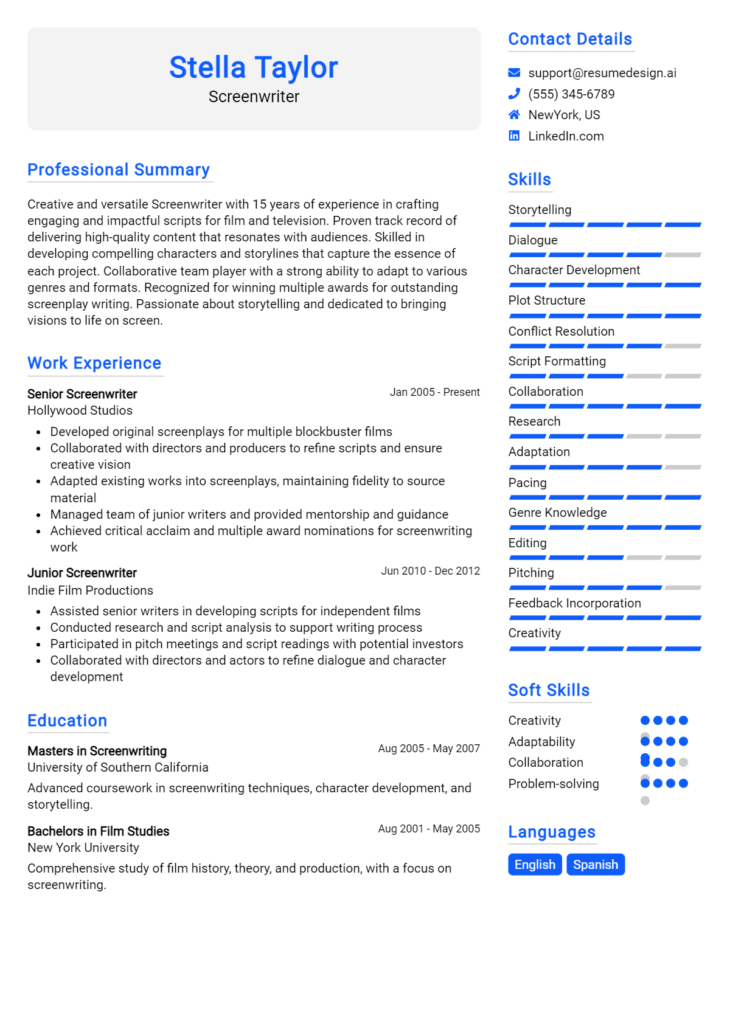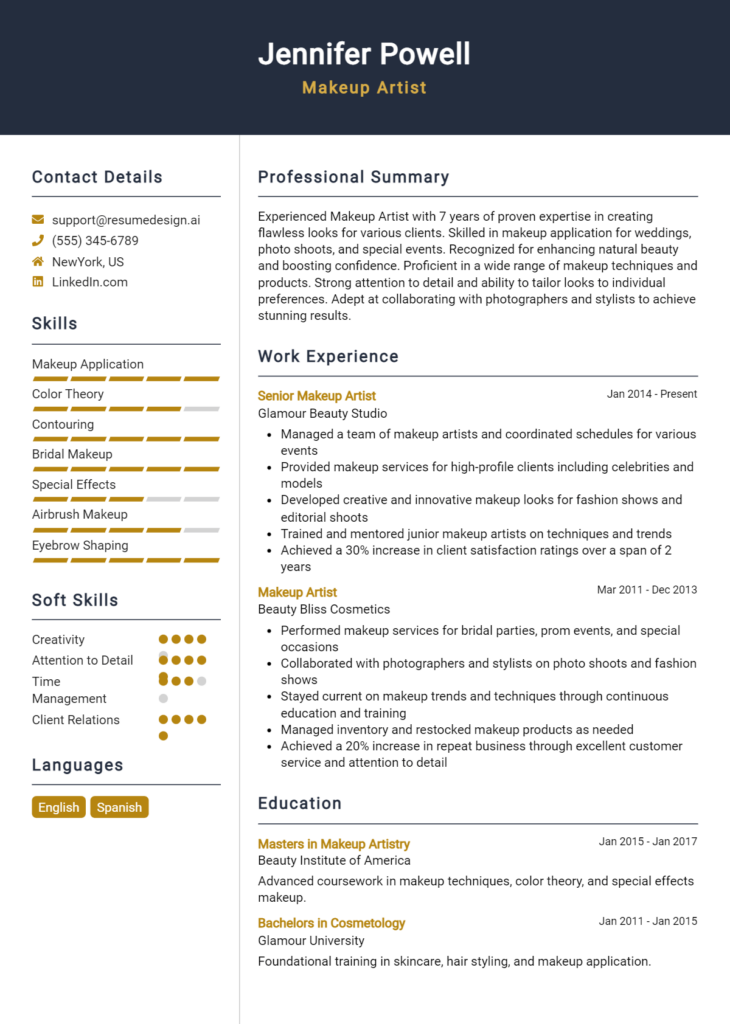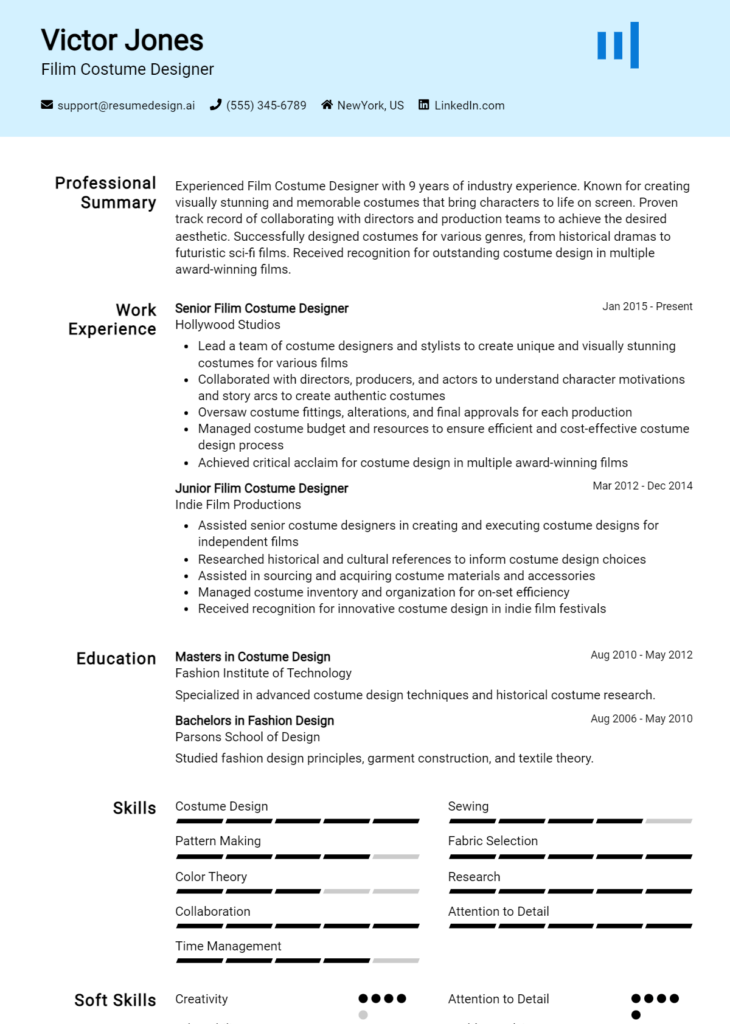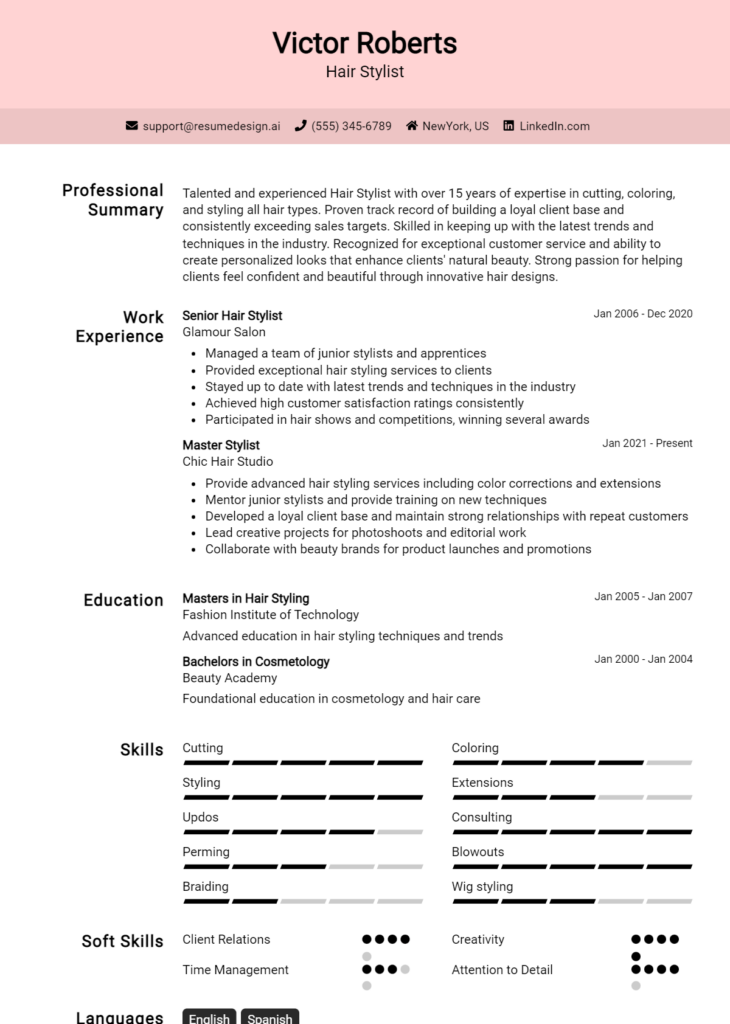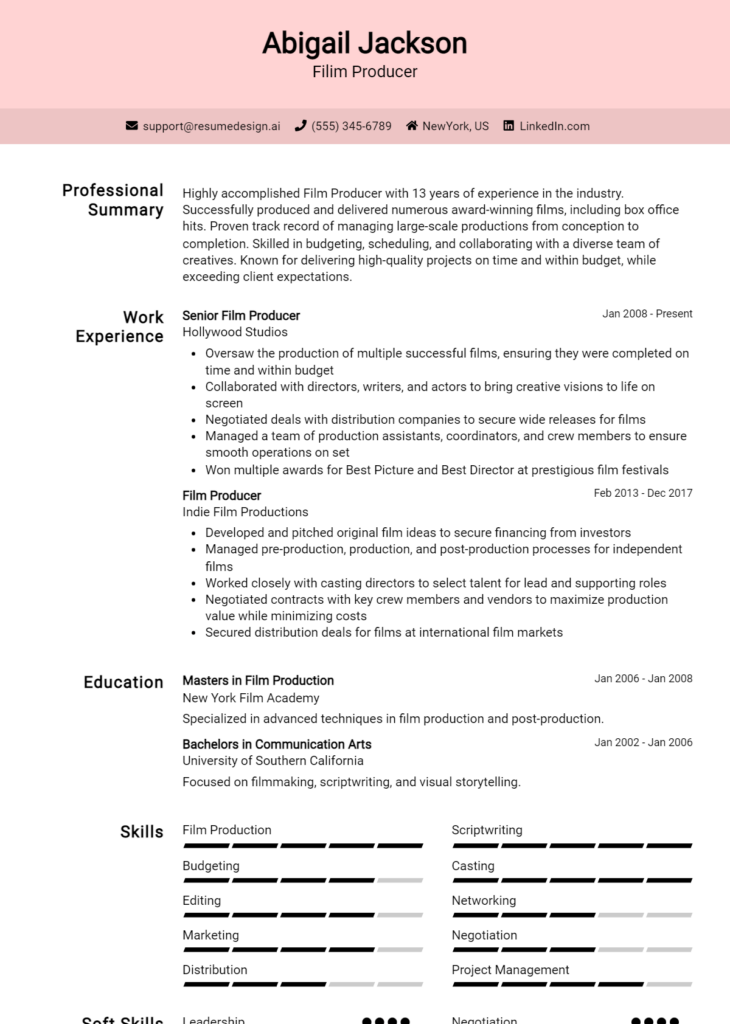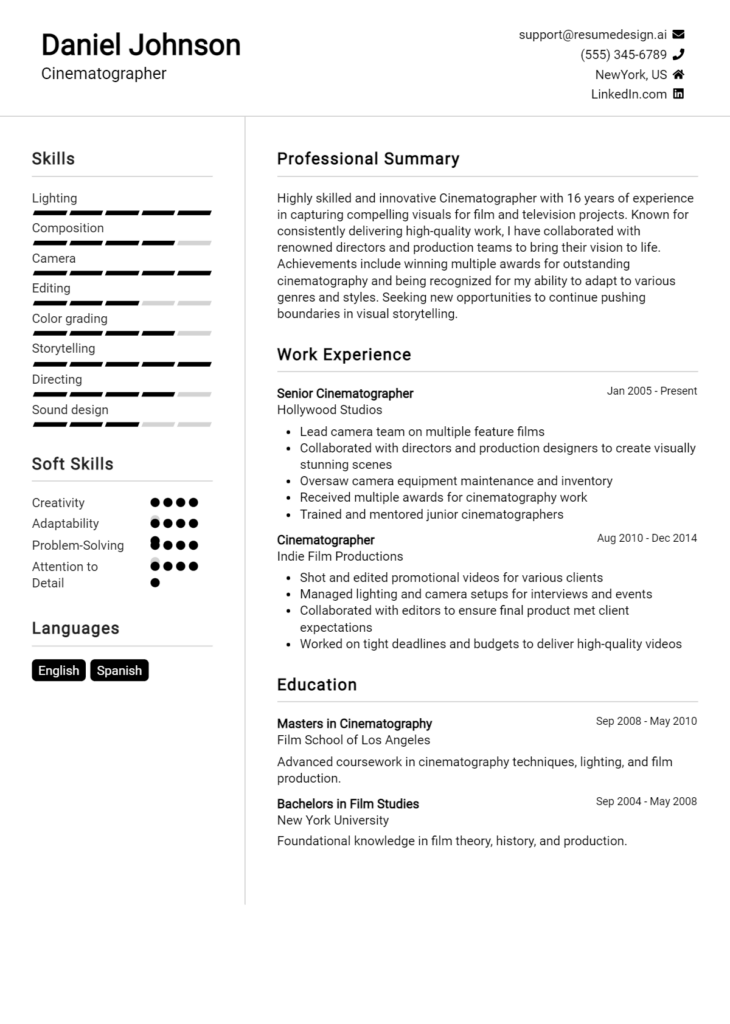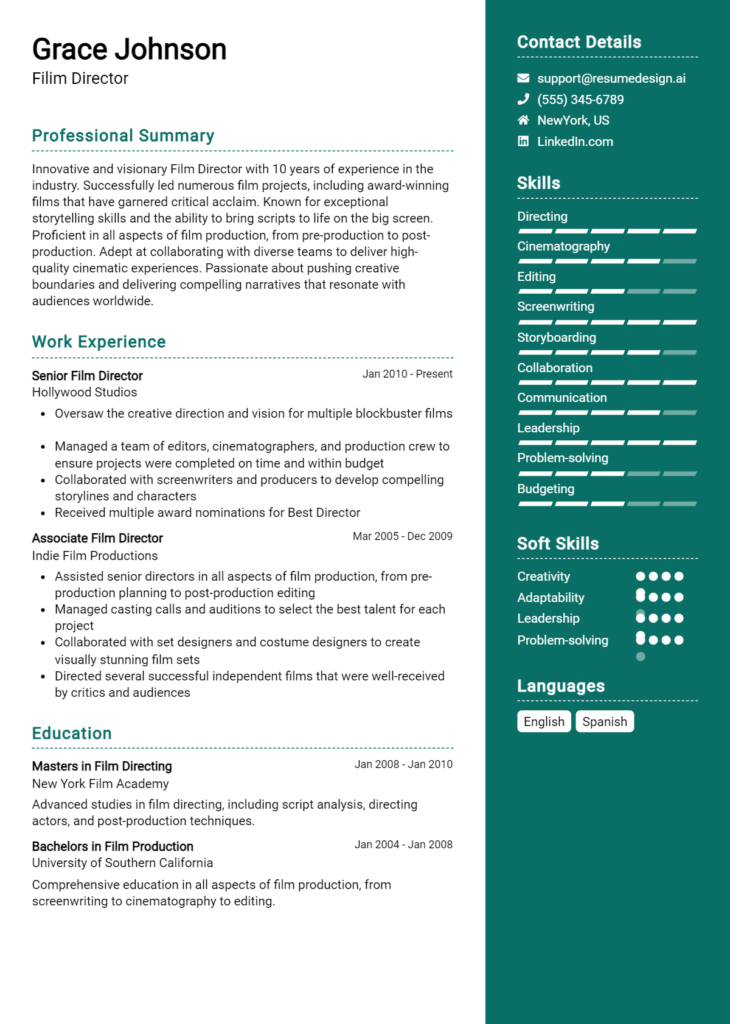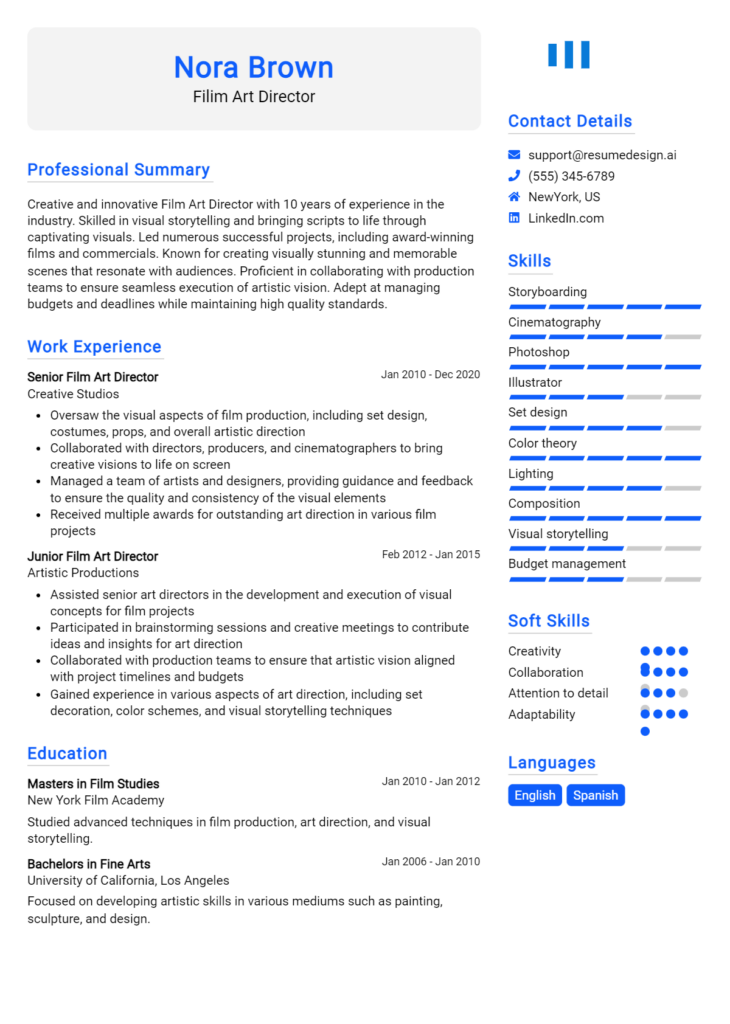Production Designer Core Responsibilities
A Production Designer plays a crucial role in the visual storytelling of a project, effectively bridging various departments such as art, direction, and cinematography. They are responsible for conceptualizing and creating the overall aesthetic, ensuring that sets and locations align with the narrative vision. Essential skills include strong technical knowledge of design software, operational management, and problem-solving abilities. These competencies are vital for achieving organizational goals and delivering a cohesive final product. A well-structured resume can effectively highlight these qualifications, showcasing the candidate’s ability to contribute significantly to the production team.
Common Responsibilities Listed on Production Designer Resume
- Develop and present design concepts and visual themes.
- Collaborate with directors and producers to align on artistic vision.
- Create detailed set designs and layouts for production.
- Oversee the construction and decoration of sets.
- Manage budgets and schedules related to design projects.
- Work closely with the art department to ensure cohesive designs.
- Conduct research to inform design choices and historical accuracy.
- Coordinate with lighting and camera departments for optimal visual impact.
- Supervise and mentor junior designers and assistants.
- Adapt designs based on feedback from stakeholders.
- Ensure all designs comply with safety regulations and standards.
High-Level Resume Tips for Production Designer Professionals
In the competitive world of production design, a well-crafted resume serves as your first introduction to potential employers, making it a crucial tool in your job search arsenal. Your resume is not just a list of past jobs; it’s a reflection of your unique skills, creative vision, and significant achievements within the industry. A strong resume can set you apart from the crowd, showcasing your ability to bring concepts to life and collaborate effectively with various teams. In this guide, we will provide practical and actionable resume tips specifically tailored for Production Designer professionals, helping you create a compelling narrative that resonates with hiring managers.
Top Resume Tips for Production Designer Professionals
- Tailor your resume to each job description by incorporating keywords and phrases that reflect the specific requirements of the position.
- Highlight your relevant experience prominently, focusing on projects that showcase your skills in set design, art direction, and visual storytelling.
- Quantify your achievements where possible, such as noting the budget sizes you managed or the number of projects you successfully completed on time.
- Include a dedicated skills section that emphasizes industry-specific tools and software, such as AutoCAD, SketchUp, or Adobe Creative Suite.
- Showcase your collaboration skills by mentioning cross-functional teamwork with directors, cinematographers, and other creative professionals.
- Incorporate visuals or links to your portfolio if applicable, allowing potential employers to see your work firsthand.
- Keep your resume concise and focused, ideally limited to one or two pages, to ensure that hiring managers can quickly grasp your qualifications.
- Utilize a clean and professional layout that mirrors your design sensibility, using consistent fonts, spacing, and colors.
- Consider including a section for professional development, such as workshops or certifications that enhance your skill set.
- Proofread thoroughly to eliminate any errors in grammar or formatting, as attention to detail is critical in the production design field.
By implementing these tips, you can significantly increase your chances of landing a job in the Production Designer field. A well-structured resume that effectively highlights your skills and achievements will not only capture the attention of hiring managers but also demonstrate your commitment to your craft, making you a standout candidate in a competitive landscape.
Why Resume Headlines & Titles are Important for Production Designer
In the competitive field of production design, a well-crafted resume headline or title is crucial for standing out to hiring managers. This brief yet powerful phrase serves as the first impression of a candidate's qualifications and expertise, summarizing their unique value proposition in a concise manner. A strong headline can immediately grab the attention of hiring managers, effectively communicating key skills and experience related to the role. It should be relevant, succinct, and directly aligned with the job being applied for, ensuring that the candidate makes an impactful first impression.
Best Practices for Crafting Resume Headlines for Production Designer
- Keep it concise: Aim for a headline that is brief and to the point, ideally 5-10 words long.
- Make it role-specific: Tailor your headline to reflect the specific position you are applying for.
- Highlight key skills: Incorporate essential skills that are pertinent to production design, such as creativity, technical proficiency, or project management.
- Include relevant experience: Mention years of experience or notable projects to enhance credibility.
- Use industry keywords: Utilize terms that are commonly recognized in the production design field to optimize for applicant tracking systems.
- Reflect your unique style: Infuse your headline with your personal brand or design philosophy to stand out.
- Avoid jargon: Use clear and straightforward language that is easily understandable.
- Test and revise: Experiment with different headlines to see which resonates best and revise accordingly.
Example Resume Headlines for Production Designer
Strong Resume Headlines
Creative Production Designer with 10+ Years in Film and Television
Award-Winning Production Designer Specializing in Immersive Environments
Innovative Production Designer with Expertise in Sustainable Design Practices
Detail-Oriented Production Designer Driven by Visual Storytelling
Weak Resume Headlines
Production Designer Looking for Opportunities
Experienced Designer Seeking Work
The strong headlines are effective because they immediately convey the candidate's qualifications and unique selling points, using specific language that highlights relevant skills and experience. They provide a clear picture of the candidate's capabilities and what they bring to the table. In contrast, the weak headlines fail to impress because they lack specificity and do not highlight any unique strengths or relevant experience, making them forgettable in a sea of applicants. Strong headlines create a memorable first impression, while weak ones leave hiring managers wanting more detail.
Writing an Exceptional Production Designer Resume Summary
A well-crafted resume summary is crucial for a Production Designer as it serves as the first impression to hiring managers. This brief yet powerful introduction highlights a candidate's key skills, relevant experience, and notable accomplishments, setting the tone for the rest of the resume. A strong summary is concise and impactful, providing a snapshot that quickly captures attention and showcases how the candidate aligns with the specific job they are applying for. By tailoring this section to the job description, candidates can effectively communicate their unique value proposition in a competitive field.
Best Practices for Writing a Production Designer Resume Summary
- Quantify Achievements: Use numbers and data to showcase your contributions and successes.
- Focus on Skills: Highlight specific skills relevant to production design, such as software proficiency or design techniques.
- Tailor for the Job: Customize your summary to reflect the requirements and language of the job description.
- Keep it Concise: Aim for 3-5 sentences that deliver maximum impact without unnecessary fluff.
- Highlight Relevant Experience: Mention years of experience and types of projects you’ve worked on that resonate with the job.
- Showcase Creativity: Incorporate unique aspects of your design style that differentiate you from other candidates.
- Use Action Words: Start with strong action verbs to convey confidence and proactivity.
- Avoid Jargon: Ensure your summary is accessible and understandable to all potential readers, not just industry insiders.
Example Production Designer Resume Summaries
Strong Resume Summaries
Dynamic Production Designer with over 8 years of experience in film and television, successfully leading design teams on projects that have collectively grossed over $50 million. Proficient in Adobe Creative Suite and 3D modeling software, I excel in creating visually compelling narratives that enhance storytelling.
Creative and detail-oriented Production Designer with a proven track record of transforming concepts into stunning visual realities. Led the design for a feature film that won 3 awards, including Best Art Direction, and increased production efficiency by 30% through innovative design solutions.
Versatile Production Designer skilled in both digital and traditional design methods, with 10+ years of experience in high-pressure environments. Successfully managed over 15 productions, consistently delivering projects on time and within budget, while enhancing audience engagement through immersive set designs.
Weak Resume Summaries
Experienced Production Designer looking for new opportunities in the film industry. I have worked on several projects and have a good understanding of design.
Production Designer with a background in art and design. I am creative and can work well with teams on various projects.
The strong resume summaries effectively highlight quantifiable achievements, specific skills, and direct relevance to the Production Designer role, making them compelling to hiring managers. In contrast, the weak summaries lack detail, fail to showcase unique contributions, and present a generic overview that doesn't distinguish the candidate from others. By focusing on measurable outcomes and tailored skills, strong summaries create a powerful first impression, while weak summaries leave much to be desired.
Work Experience Section for Production Designer Resume
The work experience section of a Production Designer resume is vital as it serves as a testament to the candidate's technical skills, leadership capabilities, and the quality of work they can deliver. This section not only highlights the designer's experience with various production tools and techniques but also demonstrates their ability to manage teams effectively and collaborate with other departments. By quantifying achievements and aligning their experiences with industry standards, candidates can provide potential employers with a clear picture of their qualifications and contributions to past projects.
Best Practices for Production Designer Work Experience
- Detail technical skills and software proficiency relevant to production design.
- Quantify achievements with specific metrics, such as budget management and project timelines.
- Highlight leadership roles and team management experiences.
- Showcase collaboration with directors, producers, and other departments.
- Use industry-standard terminology to enhance the professionalism of the resume.
- Tailor experiences to align with the job description and desired qualifications of the position.
- Include a variety of projects, showcasing versatility in different types of productions.
- Provide context for the projects, including the scale and budget, to illustrate the level of responsibility held.
Example Work Experiences for Production Designer
Strong Experiences
- Led a team of 10 in the design and execution of a $5 million feature film, completing the project 2 weeks ahead of schedule and under budget by 15%.
- Collaborated with the cinematography team to create visually compelling sets that enhanced the storytelling, resulting in a 20% increase in audience engagement metrics.
- Managed the production design for a multi-episode television series, coordinating with multiple departments and achieving a 95% satisfaction rating from the client.
- Implemented innovative design solutions using sustainable materials, reducing production costs by 10% while maintaining high-quality standards.
Weak Experiences
- Worked on various projects.
- Responsible for assisting in set design.
- Helped with the overall look of a production.
- Participated in team meetings.
The examples of strong experiences stand out due to their specificity and quantifiable outcomes, clearly illustrating the candidate's impact on projects. They demonstrate technical leadership, collaboration, and measurable success, which are essential for a Production Designer role. In contrast, the weak experiences lack detail and fail to convey the candidate's actual contributions, making them less compelling to potential employers. Strong experiences provide context and evidence of skills, while weak experiences appear vague and unimpressive, failing to capture the candidate's true potential.
Education and Certifications Section for Production Designer Resume
The education and certifications section of a Production Designer resume plays a crucial role in demonstrating the candidate's academic background and industry-relevant qualifications. This section not only highlights formal education, such as degrees in design, fine arts, or architecture, but also emphasizes certifications and specialized training that showcase a commitment to continuous learning and professional development. By providing relevant coursework, recognized certifications, and any specialized training, candidates can significantly enhance their credibility and align their skills with the specific demands of the job role, making them more appealing to potential employers.
Best Practices for Production Designer Education and Certifications
- Include degrees in relevant fields such as Fine Arts, Interior Design, or Theater Production.
- List industry-recognized certifications, such as those from the Art Directors Guild or other professional associations.
- Highlight relevant coursework that directly applies to production design, showing a solid foundation in the discipline.
- Emphasize specialized training in software commonly used in production design, like AutoCAD or Adobe Creative Suite.
- Include any workshops or seminars attended that are relevant to the field, demonstrating a commitment to ongoing education.
- Ensure all information is up-to-date, reflecting the latest industry trends and practices.
- Use a clean and organized format to make this section easy to read and visually appealing.
- Tailor the content to the specific job description, emphasizing the most relevant qualifications for each application.
Example Education and Certifications for Production Designer
Strong Examples
- Bachelor of Fine Arts in Production Design, New York University, Tisch School of the Arts
- Certified Production Designer (CPD) from the Art Directors Guild
- Advanced Certificate in Set Design from the Royal Academy of Dramatic Art
- Coursework in Lighting Design and Scenic Art Techniques, University of California, Los Angeles
Weak Examples
- Associate Degree in General Studies, Local Community College
- Certification in Basic Photography from an Online Course
- High School Diploma, Anytown High School (Graduated 2005)
- Outdated software training in Microsoft Office Suite
The strong examples are considered effective because they directly relate to the skills and knowledge necessary for a Production Designer, showcasing a solid educational foundation and relevant certifications that enhance the candidate's credibility. In contrast, the weak examples lack relevance to the production design field, either being too general or outdated, which does not support the candidate's qualifications for specialized roles in production design.
Top Skills & Keywords for Production Designer Resume
In the competitive field of production design, a well-crafted resume is essential to showcase your expertise and creativity. Highlighting the right skills can make a significant difference in capturing the attention of hiring managers and illustrating your capability to contribute to a project. A strong combination of both hard and soft skills not only demonstrates your technical proficiency but also your ability to collaborate effectively within a team. This balance is crucial, as production designers must navigate both the artistic and logistical aspects of their roles. To enhance your resume, consider integrating relevant skills that reflect your unique abilities and experiences.
Top Hard & Soft Skills for Production Designer
Soft Skills
- Creativity and Innovation
- Communication Skills
- Team Collaboration
- Problem-Solving Ability
- Attention to Detail
- Time Management
- Adaptability
- Leadership Qualities
- Critical Thinking
- Interpersonal Skills
Hard Skills
- Proficiency in Design Software (e.g., AutoCAD, SketchUp)
- Knowledge of Color Theory
- Understanding of Materials and Textiles
- Set Design and Construction Techniques
- Digital Rendering
- Budget Management
- Research and Development in Design
- Scenic Design
- Lighting Design
- Art Direction
In addition to these skills, showcasing your relevant work experience can further bolster your resume, highlighting how you have applied your skills in real-world scenarios. By presenting a comprehensive view of your capabilities, you position yourself as a strong candidate in the field of production design.
Stand Out with a Winning Production Designer Cover Letter
Dear [Hiring Manager's Name],
I am writing to express my enthusiasm for the Production Designer position at [Company Name] as advertised on [where you found the job listing]. With a robust background in creating immersive visual environments and a passion for storytelling through design, I am excited about the opportunity to contribute to your team. My experience spans across various media, including film, television, and theater, allowing me to bring a diverse perspective to every project I undertake.
Throughout my career, I have successfully collaborated with directors, cinematographers, and other creative professionals to conceptualize and execute design visions that resonate with audiences. For example, during my time with [Previous Company Name], I led the design for a critically acclaimed short film that not only achieved stunning visual aesthetics but also enhanced the narrative through meticulously crafted sets and props. My ability to balance creativity with practical considerations, such as budget constraints and timelines, has been instrumental in delivering projects that exceed expectations.
I am particularly drawn to [Company Name] because of your commitment to innovative storytelling and your impressive portfolio of work in the industry. I am eager to bring my expertise in CAD software, model-making, and set dressing to your team, ensuring that every visual element contributes to the overall narrative. I thrive in fast-paced environments and am always looking to push the boundaries of design, and I believe that my skills and vision align perfectly with your company’s goals.
Thank you for considering my application. I am excited about the possibility of discussing how my background, skills, and enthusiasm for production design can add value to [Company Name]. I look forward to the opportunity to contribute my creative talents to your esteemed projects.
Warm regards,
[Your Name]
[Your Phone Number]
[Your Email Address]
[Your LinkedIn Profile or Website]
Common Mistakes to Avoid in a Production Designer Resume
When crafting a resume as a Production Designer, it's essential to present your skills and experience effectively to stand out in a competitive field. However, many candidates fall into common pitfalls that can detract from their qualifications. Avoiding these mistakes can enhance your chances of making a positive impression on potential employers. Here are some common errors to steer clear of when creating your Production Designer resume:
Neglecting to Tailor Your Resume: Failing to customize your resume for each job application can make you seem less interested in the position. Use keywords from the job description to demonstrate your fit.
Overloading with Technical Jargon: While you may be well-versed in industry-specific terminology, using excessive jargon can confuse hiring managers. Aim for clarity and balance between technical language and accessible descriptions.
Lack of Visual Elements: As a Production Designer, your ability to create visually appealing designs is crucial. A plain resume may not showcase your design sensibilities. Incorporate tasteful design elements that reflect your style.
Ignoring Relevant Experience: Some candidates focus too heavily on unrelated work experience. Ensure you highlight projects, internships, and volunteer work relevant to production design to showcase your applicable skills.
Inadequate Project Descriptions: Simply listing projects without detailing your specific contributions can weaken your resume. Use bullet points to describe your role, the challenges faced, and the impact of your work.
Omitting a Portfolio Link: A Production Designer's portfolio is crucial for demonstrating your work. Neglecting to include a link to your online portfolio can result in missed opportunities to showcase your skills.
Using an Unprofessional Email Address: Your email address is part of your professional brand. Avoid using personal or whimsical email addresses; opt for a straightforward format that includes your name.
Failing to Proofread: Spelling and grammatical errors can undermine your professionalism. Always proofread your resume multiple times or have someone else review it to ensure clarity and correctness.
Conclusion
As we explored the essential responsibilities and skills of a Production Designer, it's clear that this role is pivotal in creating the visual narrative of a project. From collaborating with directors and cinematographers to developing concepts and overseeing the set design process, a Production Designer must possess a diverse skill set that combines creativity with technical knowledge.
Understanding the importance of a well-crafted resume in showcasing these skills is vital for standing out in a competitive industry. Highlighting your experience in art direction, set decoration, and the ability to work under tight deadlines can significantly enhance your appeal to potential employers.
Now is the perfect time to review your Production Designer resume. Ensure that it reflects your unique talents and experiences accurately. To assist you in this process, consider utilizing available resources like resume templates, which can provide a solid foundation for your document. You might also find the resume builder particularly helpful for creating a professional layout that emphasizes your strengths.
Additionally, browsing through resume examples can inspire you to refine your own resume, while cover letter templates can help you craft a compelling introduction to your application. Take action today to ensure your resume is polished and ready to impress!

